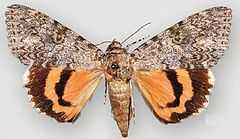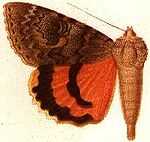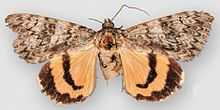Catocala junctura
- Catocala arizonae redirects here. For the species erroneously named thus by Strand in 1914, see Catocala neogama.
| Joined Underwing | |
|---|---|
 | |
| "Stretch's Underwing" imago from above | |
| Scientific classification | |
| Kingdom: | Animalia |
| Phylum: | Arthropoda |
| Subphylum: | Hexapoda |
| Class: | Insecta |
| Order: | Lepidoptera |
| Family: | Noctuidae (but see text) |
| Subfamily: | Catocalinae |
| Tribe: | Catocalini (but see text) |
| Genus: | Catocala |
| Species: | C. junctura |
| Binomial name | |
| Catocala junctura Walker, [1858] | |
| Synonyms | |
|
Numerous, see text | |
The Joined Underwing or Stretch's Underwing (Catocala junctura) is an owlet moth species. It is found throughout temperate North America. The species ranges from New York and Pennsylvania west to Montana, Colorado, Oklahoma, Arizona and into Texas, and north to southern Illinois, extreme southern Alberta and Saskatchewan; it has also been recorded west of the Rocky Mountains from California and south-eastern British Columbia. It is typically found near water, where the foodplants of its caterpillar larvae grow plentifully.
Description and ecology
The wingspan is 70–75 mm or more. The forewings are grayish to brownish with prominent black bands above, and whitish below. The upperside of the hindwings is orange-red, with two roughly concentric blackish bands on each wing and lacking hairs at the base. The outer band separates a margin that is lighter in color than the rest of the upper hindwing. The inner band does not reach the trailing edge; its hindward tip forms a hook which points back at the wing base or almost so. The underside of the hindwings is whitish along the leading edge; the trailing three-quarters of the wing are orange-red. The inner black band is present on the underwings also. As in many relatives, the foreleg tibia of this species possess no spines, while the tarsi carry three rows of spines.[1]
Adults are on the wing from June to September depending on the location. There is probably one generation per year. The caterpillars feed on willow species (Salix) and – in the west of their range – Fremont Cottonwood (Populus fremontii).
Classification
This moth is placed in the subfamily Catocalinae, either of the owlet moth family, Noctuidae, or – if the Noctuidae are circumscribed more strictly – of family Erebidae. Within the Catocalinae, it belongs to tribe Catocalini and – if the Noctuidae are circumscribed widely – subtribe Catocalina.
This species is probably related to other North American willow- and cottonwood-feeding Catocala. If so, it is one of the rather few species of this radiation that ranges east of the Rocky Mountains.[1]
Synonyms
In the past, the name Catocala aspasia has often been used for this species, but actually it seems to refer to the rather similar C. electilis.[2]
Many taxa described as distinct species or subspecies have recently been merged with C. junctura and are considered mere forms without taxonomic rank; the alternate vernacular name "Stretch's Underwing" in fact refers to one of these, the former C. stretchii. Not all authors have already adopted these changes, which are probably warranted however. The junior synonyms and other invalid taxa used for the Joined Underwing are thus:[2]
|
|
Footnotes
References
| Wikimedia Commons has media related to Catocala junctura. |
- Nelson, John M. & Loy, Peter W. (1983): The Underwing Moths (Lepidoptera: Noctuidae) of Oklahoma. Proceedings of the Oklahoma Academy of Science 63: 60-67. PDF fulltext
- Savela, Markku (2011): Markku Savela's Lepidoptera and some other life forms: Catocala. Version of 2012-FEB-05. Retrieved 2012-MAR-29.

